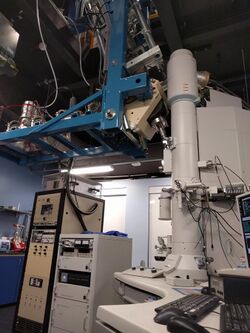MIAMI Facilities
Topic: Organization
 From HandWiki - Reading time: 4 min
From HandWiki - Reading time: 4 min
The MIAMI facility (acronym for Microscopes and Ion Accelerators for Materials Investigation) is a scientific laboratory located within the Ion Beam Centre[1] at the University of Huddersfield. This facility is dedicated to the study of the interaction of ion beams with matter. The facilities combine ion accelerators in situ with Transmission Electron Microscopes (TEM): a technique that allows real-time monitoring of the effects of radiation damage on the microstructures of a wide variety of materials. Currently the laboratory operates two such systems MIAMI-1 and MIAMI-2 that are the only facilities of this type in the United Kingdom, with only a few other such systems in the world.[2] The MIAMI facility is also part of the UKNIBC[3] (UK National Ion Beam Centre) along with the Universities of Surrey[4] and Manchester,[5] which provides a single point of access to a wide range of accelerators and techniques.
MIAMI-1
MIAMI-1 consists of a JEOL 2000FX TEM combined with a 10 keV Colutron ion source that can be post accelerated up to a 100 keV.[6] This system was initially constructed at the University of Salford in 2008 and moved to the University of Huddersfield in 2011. It is capable of irradiating materials with Inert gas atoms within the energy range of 2-100 keV, enabling the observation at the nanoscale of displacing irradiation. In particular it has been used to observe effects such as: large sputtering yields of gold nanoparticles that have been irradiated with Xe ions;[7] kink band formation in graphite under heavy ion irradiation;[8] and the observation of ordered arrays of helium nanobubbles in tungsten.[9]
MIAMI-2
Recently built within the MIAMI facility is the new MIAMI-2 system,[10] this was funded by an EPSRC grant that was awarded in 2015[11] and was officially opened on 16 March 2018[12] by Sir Patrick Stewart and Professor Stephen E. Donnelly (the Facility Director at the time). MIAMI-2 consists of two ion beams: a 10-350 kV medium-energy beamline (National Electrostatic Corp.) capable of running most ions up to Pb, at energies > 1 MeV (when using triple-charged ions); and a 1-20 keV low energy beam for light ions (H,He). These are coupled with a 300 kV H-9500 Hitachi TEM, that is equipped with EELS and EDS for elemental and chemical analysis and a gas injection system to allow for the ion irradiation of materials under non-ambient conditions (> 1 Pa). The primary application of the dual ion beam capability of the MIAMI-2 system is to study the synergistic effects of large amounts of damage from the heavy ion and the injection of He or H gas (to represent transmutation gas build up) as to better replicate the effects of neutron irradiation. One of the initial studies on the MIAMI-2 system has shown that tungsten (the material for choice in the divertor armour in the ITER and DEMO Fusion reactors) suffers a buildup of a higher number of immobile defects which inevitably cause increased embrittlement when irradiated under dual heavy and light ion irradiation as compared with light ion irradiation alone.[13][14]
References
- ↑ "Ion Beam Centre (IBC) - University of Huddersfield". https://research.hud.ac.uk/institutes-centres/centres/ibc/.
- ↑ Hinks, J.A. (1 December 2009). "A review of transmission electron microscopes with in situ ion irradiation". Nuclear Instruments and Methods in Physics Research Section B: Beam Interactions with Materials and Atoms 267 (23–24): 3652–3662. doi:10.1016/j.nimb.2009.09.014. Bibcode: 2009NIMPB.267.3652H.
- ↑ "UKNIBC Website". http://www.uknibc.co.uk/.
- ↑ "Surrey Ion Beam Centre". https://www.surrey.ac.uk/ion-beam-centre.
- ↑ "Dalton Cumbrian Facility". http://www.dalton.manchester.ac.uk/research/dcf/.
- ↑ Hinks, J. A.; van den Berg, J. A.; Donnelly, S. E. (1 March 2011). "MIAMI: Microscope and ion accelerator for materials investigations". Journal of Vacuum Science & Technology A: Vacuum, Surfaces, and Films 29 (2): 021003. doi:10.1116/1.3543707. Bibcode: 2011JVSTA..29b1003H. http://eprints.hud.ac.uk/id/eprint/16016/1/MIAMI_-_Microscope_and_ion_accelerator_for_materials_investigations_%28Final%29.pdf.
- ↑ Greaves, G.; Hinks, J. A.; Busby, P.; Mellors, N. J.; Ilinov, A.; Kuronen, A.; Nordlund, K.; Donnelly, S. E. (8 August 2013). "Enhanced Sputtering Yields from Single-Ion Impacts on Gold Nanorods". Physical Review Letters 111 (6): 065504. doi:10.1103/PhysRevLett.111.065504. PMID 23971585. Bibcode: 2013PhRvL.111f5504G. http://eprints.hud.ac.uk/id/eprint/18151/1/PhysRevLett.111.065504.pdf.
- ↑ Hinks, J.A.; Haigh, S.J.; Greaves, G.; Sweeney, F.; Pan, C.T.; Young, R.J.; Donnelly, S.E. (1 March 2014). "Dynamic microstructural evolution of graphite under displacing irradiation". Carbon 68: 273–284. doi:10.1016/j.carbon.2013.11.002. http://eprints.hud.ac.uk/id/eprint/19098/1/Dynamic_Microstructural_Evolution_of_Graphite_under_Displacing_Irradiation_%28Unformatted_Proof%29.pdf.
- ↑ Harrison, R. W.; Greaves, G.; Hinks, J. A.; Donnelly, S. E. (10 August 2017). "Engineering self-organising helium bubble lattices in tungsten". Scientific Reports 7 (1): 7724. doi:10.1038/s41598-017-07711-w. PMID 28798360. Bibcode: 2017NatSR...7.7724H.
- ↑ Greaves, G. (2019). "New Microscope and Ion Accelerators for Materials Investigations (MIAMI-2) system at the University of Huddersfield" (in en). NIMA 931: 37–43. doi:10.1016/j.nima.2019.03.074. Bibcode: 2019NIMPA.931...37G.
- ↑ "Grants on the web". EPSRC. http://gow.epsrc.ukri.org/NGBOViewGrant.aspx?GrantRef=EP/M028283/1.
- ↑ "Sir Patrick Stewart launches £3.5m particle accelerator" (in en). BBC News. 2018-03-16. https://www.bbc.co.uk/news/uk-england-leeds-43431023.
- ↑ "Tungsten too brittle for nuclear fusion reactors | IOM3" (in en). http://www.iom3.org/materials-world-magazine/news/2018/jun/08/tungsten-too-brittle-nuclear-fusion-reactors.
- ↑ Harrison, R.W.; Hinks, J.A.; Donnelly, S.E. (2018-06-01). "Influence of pre-implanted helium on dislocation loop type in tungsten under self-ion irradiation" (in en). Scripta Materialia 150: 61–65. doi:10.1016/j.scriptamat.2018.02.040. ISSN 1359-6462. https://www.research.manchester.ac.uk/portal/files/82371256/Influence_of_pre_implanted_He_on_the_dislocation_type_in_self_ion_irradiated_tungsten.pdf.
External links
[ ⚑ ] 53°38′35″N 1°46′47″W / 53.64318°N 1.77959°W
 |
 KSF
KSF


